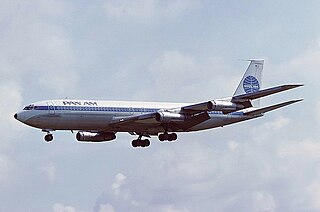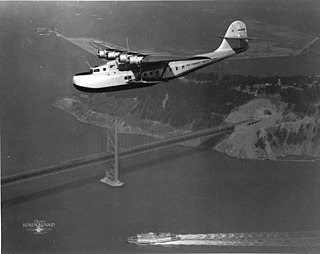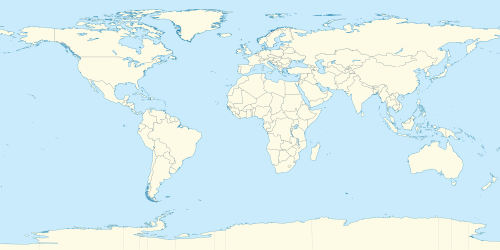
Pan American World Airways, originally founded as Pan American Airways and more commonly known as Pan Am, was an airline that was the principal and largest international air carrier and unofficial overseas flag carrier of the United States for much of the 20th century. It was the first airline to fly worldwide and pioneered numerous innovations of the modern airline industry, such as jumbo jets and computerized reservation systems. Until its dissolution on December 4, 1991, Pan Am "epitomized the luxury and glamour of intercontinental travel", and it remains a cultural icon of the 20th century, identified by its blue globe logo, the use of the word "Clipper" in its aircraft names and call signs, and the white uniform caps of its pilots.

China Clipper (NC14716) was the first of three Martin M-130 four-engine flying boats built for Pan American Airways and was used to inaugurate the first commercial transpacific airmail service from San Francisco to Manila on November 22, 1935. Built at a cost of $417,000 by the Glenn L. Martin Company in Baltimore, Maryland, it was delivered to Pan Am on October 9, 1935. It was one of the largest airplanes of its time.

The Boeing 314 Clipper was an American long-range flying boat produced by Boeing from 1938 to 1941. One of the largest aircraft of its time, it had the range to cross the Atlantic and Pacific oceans. For its wing, Boeing re-used the design from the earlier XB-15 bomber prototype. Twelve Clippers were built, nine of which served with Pan Am.

Edwin Charles Musick was chief pilot for Pan American World Airways and pioneered many of Pan Am's transoceanic routes including the famous route across the Pacific Ocean, ultimately reaching the Philippine Islands, on the China Clipper.

The Sikorsky S-42 was a commercial flying boat designed and built by Sikorsky Aircraft to meet requirements for a long-range flying boat laid out by Pan American World Airways in 1931. The innovative design included wing flaps, variable-pitch propellers, and a tail-carrying full-length hull. The prototype first flew on 29 March 1934, and, in the period of development and test flying that followed, quickly established ten world records for payload-to-height. The "Flying Clipper" and the "Pan Am Clipper" were other names for the S-42.

The Sikorsky S-40 was an American amphibious flying boat built by Sikorsky in the early 1930s for Pan American Airways. During WW2 they were used by the United States Navy for training.

Pan Am Flight 214 was a scheduled flight of Pan American World Airways from San Juan, Puerto Rico, to Baltimore, and then to Philadelphia in the United States. On December 8, 1963, while flying from Baltimore to Philadelphia, the Boeing 707-121 crashed near Elkton, Maryland. All 81 passengers and crew on the plane were killed. The crash was Pan Am's first fatal accident with the 707, which it had introduced to its fleet five years earlier.

The Martin 156, referred to in the press variously as the "Russian Clipper", "Moscow Clipper", or "Soviet Clipper" was a very large flying boat aircraft intended for trans-Pacific service. The single example of the M-156 was designed and built in response to a request from Pan American World Airways to provide a longer-range replacement for the Martin M-130.

The Martin M-130 was a commercial flying boat designed and built in 1935 by the Glenn L. Martin Company in Baltimore, Maryland, for Pan American Airways. Three were built: the China Clipper, the Philippine Clipper and the Hawaii Clipper. All three had crashed by 1945. A similar flying boat design called the Martin 156 and named Russian Clipper, was built for the Soviet Union; it had a larger wing and twin vertical stabilizers.

Pan Am Flight 806 was an international scheduled flight from Auckland, New Zealand, to Los Angeles, California, with intermediate stops at Pago Pago, American Samoa and Honolulu, Hawaii. On January 30, 1974, the Boeing 707 Clipper Radiant crashed on approach to Pago Pago International Airport, killing 87 passengers and ten crew members.

Pan Am Flight 1104, trip no. 62100, was a Martin M-130 flying boat nicknamed the Philippine Clipper that crashed on the morning of January 21, 1943, in Northern California. The aircraft was operated by Pan American Airways, and was carrying ten US Navy personnel from Pearl Harbor, Hawaii, to San Francisco, California. The aircraft crashed in poor weather into mountainous terrain about 7 mi (11 km) southwest of Ukiah, California.

Cathay Pacific Flight 780 was a flight from Juanda International Airport in Surabaya, Indonesia, to Hong Kong International Airport on 13 April 2010. On board were 309 passengers and a crew of 13. As Flight 780 neared Hong Kong, the crew were unable to change the thrust output of the engines. The aircraft, an Airbus A330-300, landed at almost twice the speed of a normal landing, suffering minor damage. The 57 passengers who sustained injuries were hurt in the ensuing slide evacuation; one of them received serious injuries.

The China Clipper flight departure site is listed as California Historical Landmark number 968. It is the site from which Pan American World Airways initiated trans-Pacific airmail service on November 22, 1935. A flying boat named China Clipper made the first trip, and the publicity for that flight caused all flying boats on that air route to become popularly known as China Clippers. For a few years, this pioneering mail service captured the public imagination like the earlier Pony Express, and offered fast luxury travel like the later Concorde.

Hawaii Clipper was one of three Pan American Airways Martin M-130 flying boats. It disappeared with six passengers and nine crew en route from Guam to Manila, on July 28, 1938.

Honolulu Clipper was the prototype Boeing 314 flying boat designed for Pan American Airways. It entered service in 1939 flying trans-Pacific routes.

Lyndonia, built 1920, was the second steam-yacht bearing the name and the third yacht built for publisher Cyrus H.K. Curtis of the Curtis Publishing Company by the then Consolidated Shipbuilding Company of Morris Heights, New York. The name is taken from the historic name of his estate, Lyndon, in Wyncote, Pennsylvania.

Pan Am Flight 843 was a scheduled domestic commercial flight from San Francisco, California, to Honolulu, Hawaii. On Monday, June 28, 1965, Clipper Friendship, the Boeing 707-321B operating this route, experienced an uncontained engine failure shortly after take-off, but was successfully able to make an emergency landing at nearby Travis Air Force Base. The engine failure had been caused by faulty installation and maintenance procedures. The accident was filmed by a passenger.

Pan Am Flight 121 was a scheduled Pan American World Airways flight from Karachi to Istanbul. On the evening of June 18, 1947, the Lockheed L-049 Constellation serving the flight, known as the Clipper Eclipse, suffered an engine failure. This led to the overheating of the remaining engines until one caught fire, which spread to the aircraft. The heat from burning magnesium parts caused the engine to fall from the aircraft, leaving it unable to maintain altitude. Early in the morning of June 19, 1947 the plane crashed in the Syrian desert 4 miles from the town of Mayadin. Fifteen people were killed, including 7 crew and 8 passengers. The three surviving crew members were third officer Gene Roddenberry, the chief purser, and one flight attendant. After rescuing passengers from the burning wreckage, Roddenberry took control as the ranking flight officer and organized scout parties to find aid. By midday, the Syrian Army took the survivors to the hospital at Deir ez-Zor. The majority returned to the United States quickly while Roddenberry remained in Syria for two weeks to answer questions about the crash from the local government.

Pan Am Flight Clipper Panama, Douglas DC-6B N5026K, was a cargo flight from Frankfurt to New York City. On 22 June 1959 it caught fire on takeoff and was destroyed. All six flight crew and two passengers survived.























